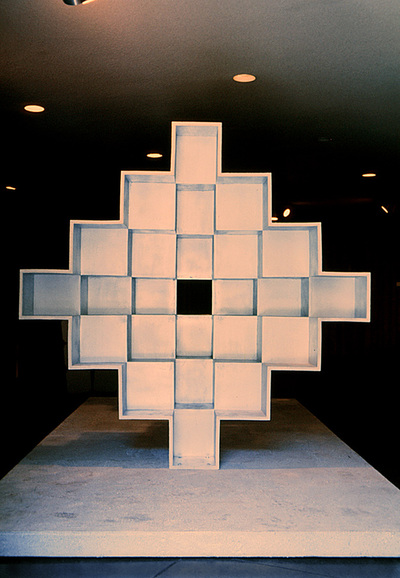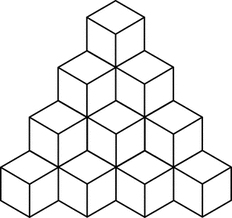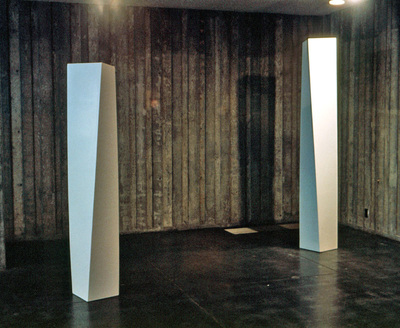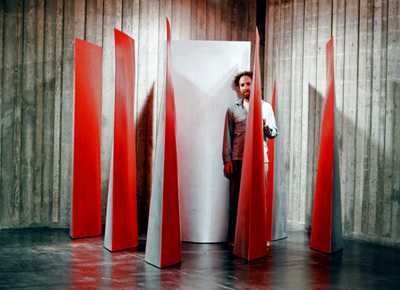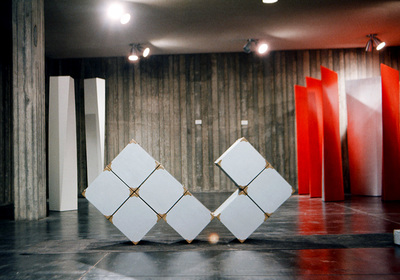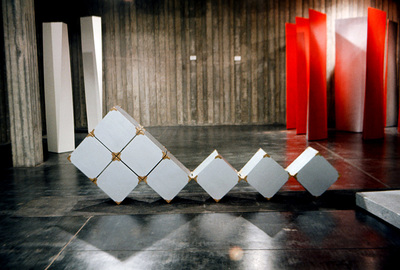NEWMAN GALLERY EXHIBIT – BERKELEY, CA.
AUGUST 1969
In 1966 I got a second job, at San Francisco State, teaching evening classes in the Graduate Department of Interdisciplinary Arts. With the extra money, I rented studio space in a West Berkeley factory that was shared by several people. There I began work on several large sculptures in wood. These were all abstract constructions in the minimalist approach of the early to mid-sixties. Sometime later I was asked to show these works in the gallery of the newly-built (1967) Newman Hall designed by Mario Ciampi, who also designed the University Art Museum in Berkeley in 1970.
AUGUST 1969
In 1966 I got a second job, at San Francisco State, teaching evening classes in the Graduate Department of Interdisciplinary Arts. With the extra money, I rented studio space in a West Berkeley factory that was shared by several people. There I began work on several large sculptures in wood. These were all abstract constructions in the minimalist approach of the early to mid-sixties. Sometime later I was asked to show these works in the gallery of the newly-built (1967) Newman Hall designed by Mario Ciampi, who also designed the University Art Museum in Berkeley in 1970.
In making these large wooden sculptures, I wanted to create modular structures and to encourage interactive viewing. Two of the sculptures were static, but presented varying aspects when seen from different viewing positions. The four other works could be rearranged to form different configurations. In two of these other pieces, the modules were hinged for folding each section, and in the other two the modules could be individually rotated.
THE TWO STATIC SCULPTURES
White Star
White Star
c. 7’x7’x7’ plus base
c. 7’x7’x7’ plus base
White Star was based on a geometric figure seen in various folk designs.
In geometry the figure is called stacked cubes.
In geometry the figure is called stacked cubes.
I wanted to show both the exterior and interior views of this figure, and I doubled the figure in mirror images attached at their shared smallest dimension, a single cube. Looking directly into one of the halves one could not see the other half through the single square opening in the center. As heavy as the piece was, I thought that it seemed light as it stood symmetrically on its “feet” of two cubes.
Two Twisted Columns
Two Twisted Columns
68”x12” x12” and 80”x12”x12”
Painted wood
68”x12” x12” and 80”x12”x12”
Painted wood
The Two Twisted Columns were made of 1/8-inch door skins with plywood squares at the tops and bottoms. Their forms each twisted at a 45º rotation, but in opposite directions. One of them was a foot higher than the other, and they were placed about eight feet apart. Had there been enough space to see them from some distance away from each column, the far column would have appeared either much taller or about the same height as the nearer one – a play on the deceptions of perspective viewing.
THE FOUR MOVABLE SCULPTURES
Rotating Column
Rotating Column
8' x 2' x 2'
Painted wood with large steel lazy susan bearings.
8' x 2' x 2'
Painted wood with large steel lazy susan bearings.
I made this Rotating Column of four equal triangular prisms in plywood. I painted each section with high gloss resin paints, one side black, another blue, and the third yellow. I fastened industrial lazy susans into the bottoms of each unit and set them into the tops of the three lower units. The heavy-duty bearings rotated quite easily on the column’s central axis, and each triangular section could be moved independently from the others. As the sections were moved, the column changed shape as well as color patterns: an interactive sculpture.
Red Forest Mix
Red Forest Mix
Nine pieces, each c. 80” x 32” x 15” at the base.
Painted wood, resin, and lazy susan bearings.
The overall placement was within a c.8’ x 8’ square.
Nine pieces, each c. 80” x 32” x 15” at the base.
Painted wood, resin, and lazy susan bearings.
The overall placement was within a c.8’ x 8’ square.
I made the Red Forest Mix units from 1/8” doorskins, with ¾” plywood bases which formed the “envelope” shapes I wanted. From the front, each unit looked like a slightly tapered rectangle, but from the side it looked like a conical colum. A viewer could enter the space of the piece and alter the configuration and the color relations by rotating one or more of the units. This simple structure offered a great many configurations. The red and silver sides were colored with sprayed acrylic paint.
Silver Snake
Silver Snake
Nine Hinged Round Segments
Solid wood with metal hinges
Each unit c. 22” x 8” x 8”
Nine Hinged Round Segments
Solid wood with metal hinges
Each unit c. 22” x 8” x 8”
I found the solid wooden round segments for this piece somewhere and connected them with metal hinges to form an articulated structure that, because of its rounded components, had the look of some sort of serpentine entity. The silver paint showed some of the dark color of the rough wood below it.
This was an extremely heavy piece and probably too dangerous to have been left unattended in this open space. I was fortunate that nobody was hurt (as far as I know) manipulating the sections. This was true of several pieces in this exhibition. The venue was essentially an open and public space, and such an element of possible physical risk to visitors would not be tolerated today.
This was an extremely heavy piece and probably too dangerous to have been left unattended in this open space. I was fortunate that nobody was hurt (as far as I know) manipulating the sections. This was true of several pieces in this exhibition. The venue was essentially an open and public space, and such an element of possible physical risk to visitors would not be tolerated today.
Eight Hinged Cubes
Eight Hinged Cubes
Wood sides, metal corners and hinges
Each cube c.12” x 12” x 12”
Wood sides, metal corners and hinges
Each cube c.12” x 12” x 12”
I built the hinged cubes of this structure out of plywood: eight boxes with brass corners similar to those on old wooden trunks. The hinges were also made of brass. This cube piece had a newly fabricated, cleaner quality compared to the rougher, more organic look of the round segment piece.
All of these pieces are now long gone, and I don’t even remember how or where they went. These pictures are all that remain of them.
All of these pieces are now long gone, and I don’t even remember how or where they went. These pictures are all that remain of them.
DADO PLAY SCULPTURE
Dado Play Sculpture
Twelve units, various sizes, from 1” pine shelving, with enamel paint.
Twelve units, various sizes, from 1” pine shelving, with enamel paint.
This was a play sculpture I made for our son’s preschool. It was an extension of my interest in interactive sculpture, this time for kids. Cut from kiln-dried 12” pine shelving, the simple dado cuts provided the connecting links for the pieces.


